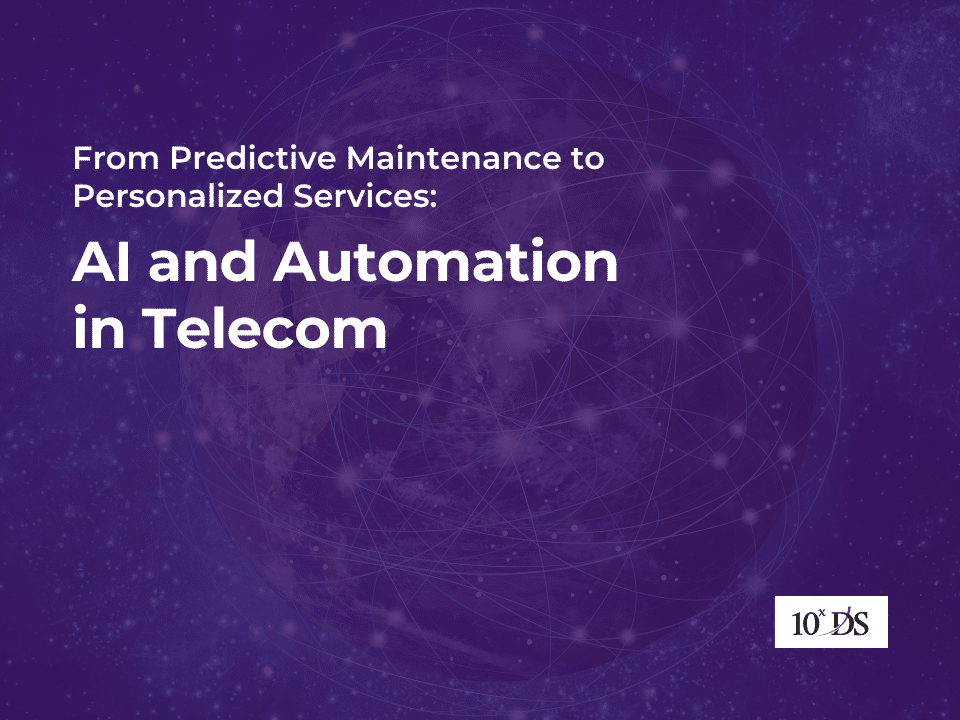
From Predictive Maintenance to Personalized Services: AI and Automation in Telecom
Before the widespread adoption ofAI, the telecom industry relied heavily on manual processes and human intervention for network management, customer service, and data analysis. Network optimization and maintenance were largely reactive, addressing issues only after they occurred, which often resulted in downtime and reduced service quality. Customer service was labor-intensive, with call centers handling a high volume of queries and complaints, leading to long wait times and inconsistent support. Fraud detection and security measures were less sophisticated, relying on basic rule-based systems that struggled to keep up with evolving threats. Operational efficiency was hampered by repetitive manual tasks, and service innovation was slower due to the time and resources required for data analysis and decision-making
After AI adoption, the telecom industry has seen remarkable improvements. As per a Survey report by NVIDIA, more than 50% of telecom companies consider AI a major factor in shaping their workspace strategies, and AI-driven solutions are anticipated to primarily enhance customer experience and reduce operational costs . The integration of automation and AI in the telecom industry is poised to lead to significant transformations across various facets of the business. Let’s delve into the key impacts of this integration.
Customer Service and Customer Experience
The advent of AI-powered chatbots and virtual assistants has revolutionized customer service in the telecom sector. These intelligent systems can efficiently handle a large volume of customer queries, providing quick and accurate responses, which enhances customer satisfaction. Customer service has been revolutionized by AI chatbots and virtual assistants, which handle millions of customer interactions efficiently and provide personalized service. For instance, Vodafone’s TOBi chatbot manages 25 to 30 million conversations monthly, enhancing customer support and reducing operational costs. Furthermore, AI’s ability to analyze customer data enables the provision of personalized services. By understanding individual preferences and behaviors, telecom companies can offer tailored recommendations and solutions, thereby improving the overall customer experience. AI optimizes network performance to provide users with seamless and reliable connectivity, which is a critical factor in user satisfaction. Proactive support systems powered by AI can identify and address issues before customers experience them, leading to a smoother and more satisfactory user experience.
Network Optimization and Maintenance
AI plays a crucial role in predictive maintenance within telecom networks. By analyzing data and identifying patterns, AI can foresee potential failures and maintenance needs before they occur. This predictive capability reduces downtime and significantly improves network reliability. Additionally, Self-Optimizing Networks (SON) are an innovative application of AI in telecom. These networks can automatically adjust parameters and configurations to enhance performance and user experience, ensuring that the network operates at its optimal level without manual intervention.
Fraud Detection and Security
AI is instrumental in enhancing security within the telecom industry. Through anomaly detection, AI algorithms can identify unusual patterns that may indicate fraudulent activities, allowing for swift intervention. Automated systems also play a vital role in maintaining robust security protocols. By continuously monitoring and updating security measures, these systems protect against evolving threats, ensuring the integrity and safety of telecom networks.
Operational Efficiency
Automation of routine tasks such as billing, data entry, and reporting can significantly reduce human error and operational costs. This process automation allows telecom employees to focus on more complex and value-added activities. AI also optimizes resource management by efficiently allocating infrastructure and personnel, ensuring that resources are utilized to their fullest potential without wastage.
Service Delivery and Innovation
The integration of automation in service delivery allows for the rapid deployment of new services and technologies. This agility keeps telecom companies competitive in a fast-evolving market. Moreover, AI-driven analysis of trends and customer needs fosters innovation, leading to the development of new products and services that meet the dynamic demands of consumers.
Data Analytics and Insights
AI enhances data processing capabilities, allowing telecom companies to quickly process large volumes of data and extract valuable insights for decision-making. This capability is crucial for understanding customer behavior and preferences, enabling the tailoring of marketing strategies and improving user experience. Enhanced data analytics thus empowers telecom companies to make informed decisions that drive business success.
Cost Reduction
The implementation of automation leads to significant cost reductions in the telecom industry. By minimizing the need for manual intervention, operational costs are lowered, and errors are reduced. Additionally, optimized network management extends the lifespan of existing infrastructure, delaying the need for new investments and thereby reducing capital expenditure.
Regulatory Compliance
AI assists telecom companies in adhering to regulatory requirements through automated compliance monitoring. These systems continuously monitor compliance metrics, ensuring that companies remain within legal boundaries. AI also plays a crucial role in managing and protecting sensitive customer data, ensuring compliance with data privacy regulations and maintaining customer trust.
Workforce Transformation
As automation and AI take over routine tasks, telecom employees have the opportunity to focus on more complex and strategic activities, leading to skill enhancement and increased job satisfaction. While some roles may become redundant, the rise of AI development, data analysis, and system management creates new job opportunities, transforming the workforce landscape.
In conclusion, the integration of automation and AI in the telecom industry brings about transformative changes that enhance efficiency, security, customer service, and innovation. These advancements not only reduce costs and improve regulatory compliance but also transform the workforce and significantly enhance user experience, positioning telecom companies for a successful and sustainable future. In summary, the integration of automation and AI in the telecom industry promises to enhance efficiency, reduce costs, improve customer satisfaction, and drive innovation. However, it also requires careful management of workforce transitions and adherence to regulatory standards to fully realize these benefits.
Talk to our experts to know more.


